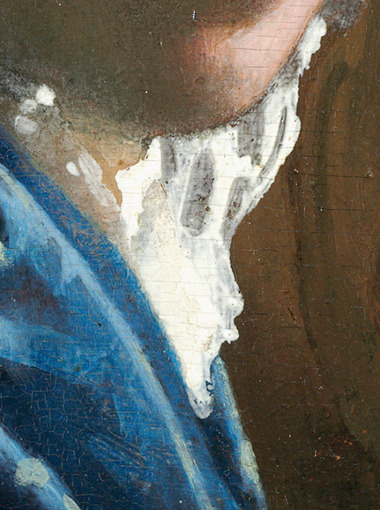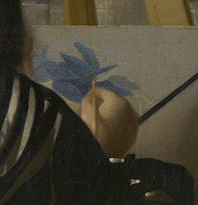Details: Vermeer's Painting Methods & Techniques
GIRL WITH A RED HAT
c. 1665-1666
oil on panel
9 x 7 1/16 in (22.8 x 18.0 cm.)
The National Gallery of Art
Washington D.C.
Andrew W. Mellon Collection
painting with the brush handle
The Girl with a Red Hat occupies a unique place in the oeuvre of Vermeer. It is one of the only two works on a wood panel and is a mere 9 1/2 x 7 1/8 in. (20 x 18 cm.) Moreover, the painting is a work of extraordinary spontaneity in conception and execution.
Under the surface we now observe lies the beginnings of a male portrait by an unknown artist (although there exist no reason why it should not be by Vermeer's hand) which can clearly be seen in a radiograph image. Just why Vermeer may have used such an unusual support has long been questioned. The reason might be a very simple one: Vermeer wanted to realize as rapidly as possible the seductive image which had grasped his imagination. The preparation of a canvas, being a rather long a laborious chore, would have delayed his pictorial impetus.
Both the painting's extremely informal atmosphere as well as the spontaneous execution would seem to confirm such a theory. Vermeer did not even entirely cover the older painting with a uniform warm ground as was his habit, rather, he passed a brown layer only over the white collar of the man which was the most distracting element and then painted directly over the rest. This might be interpreted as yet another sign of Vermeer's impatience.
The harder and less absorbent surface of the painted panel tends to enhance flowing qualities of brushwork seen in the background but, at the same time, permits an even finer degree of detail such as those seen in the rendering of the face.
Vermeer's confidence in his technical means had reached such a level that to render the shadows in the white cravat he used the tip of the brushes handle to remove the paint thus exposing the darker paint below.


